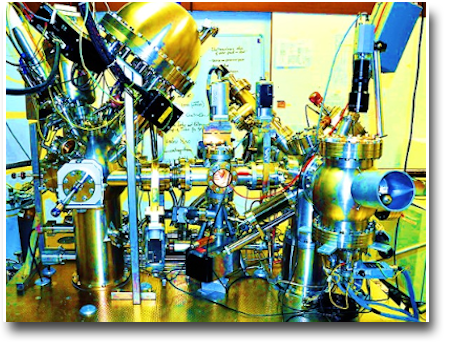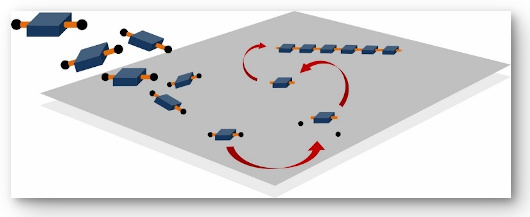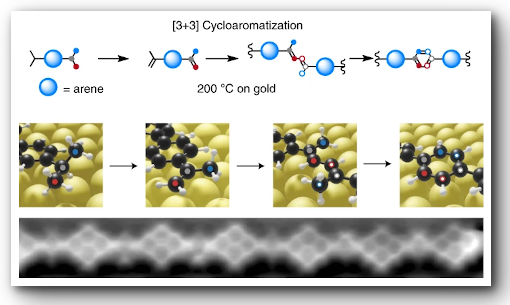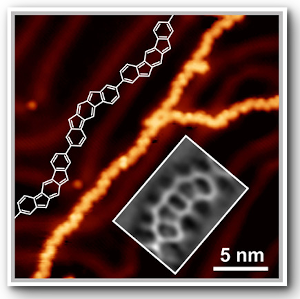
Research Activities
The On-Surface Chemistry Laboratory (ONSET), recently established at CNR-ISM, is a research environment dedicated to the study of surfaces and interfaces in ultrahigh vacuum conditions. The focus of our activity is the growth and characterization of novel, low-dimensional materials with appealing physical and chemical properties. We use our in-house experimental setup (see below), synchrotron radiation facilities and collaborations with various groups around the world to widen the fundamental knowledge on the growth, properties and functions of nanomaterials.
On-Surface Synthesis
On-surface synthesis (OSS) is a successful approach to the creation of carbon-based nanostructures that cannot be obtained via standard solution chemistry. It consists of a bottom-up strategy, based on the use of carefully designed molecular precursors as building blocks. These precursors, are equipped with functional groups that, when activated, become active sites for the intermolecular covalent coupling and allow the creation of one- or two-dimensional (1D, 2D) nanostructures. These reactions can be triggered by means of various stimuli, such as heat, light, and others. The shape and properties of the precursors determine those of the target nanostructures, offering great tuneability. Typically, atomically flat, clean metal surfaces of single crystals in ultrahigh vacuum (UHV) conditions are used as substrates, but the OSS also extends to different environments (ambient, solid-liquid interfaces) and substrates (thin films, insulating/semiconducting layers, bulk insulators). The reaction steps and products are usually monitored and characterized by scanning probe microscopies, such as scanning tunneling microscopy (STM), noncontact atomic force microscopy (nc-AFM), and by photoelectron spectroscopies, such as X-ray/UV photoelectron spectroscopy (XPS/UPS). More advanced approaches, such as temperature programmed XPS (TP-XPS), allow the tracking of relevant signals during the reaction, and the understanding of fundamental mechanistic details.

Single atom platforms for catalysis
We are currently exploring new avenues to the creation of tuneable single atom platforms (SAPs), combining the two fields of single atom catalysts (SACs) and on-surface synthesis (OSS). SACs are materials where a small amount of a catalytically active metals (e.g. Pt, Pd, Co, …) is dispersed onto the surface of a more inert host metal (e.g. Cu, Ag, Au, …) or oxide (e.g. CuOx, …). These materials have revealed promising catalytic activities with the advantage of exploiting very low concentrations of precious metals. However, they exhibit some limitations, as a poor tuneability, clustering, non-uniform distance between the active sites, and diffusion of the single atoms at elevated temperature. Our aim is to develop hybrid nanomaterials where the single metal atoms are stabilized in specifically designed coordination sites of carbon-based polymers obtained via OSS. This approach permits the achievement of catalytically active centers that are equally distributed over the surface and stable in a wide temperature range, due to the atomic precision and robustness of the extended organic template. More importantly, the ease of modification of the organic templates offers unprecedented tuneability prospects for the fine adjustment of the active site functionality.

Photochemistry of molecules on surfaces
In our laboratory, we are exploring new approaches to initiate chemical reactions of organic species on surfaces in ultrahigh vacuum conditions. In fact, in the on-surface synthesis approach, the most used chemical reaction to create covalent bonds between the organic building blocks is the dehalogenative aryl-aryl coupling (aka Ullmann coupling), which relies on the thermal activation of aryl halides on metal surfaces. However, there are many other reactions that could be used, which can also occur on different substrates and be triggered by different stimuli, as for instance light irradiation. We recently started to investigate the on-surface photoreactivity of prototypical anhydrides on semiconducting substrates, initiated by UV light irradiation. This approach entails major advantages, as the occurrence at room temperature and the achievement of desired nanostructures on substrates other than metals, thus exploiting the electronic properties of the organic layer without need of intercalation or transfer processes.

Characterization of novel nanomaterials
The combination of photoelectron spectroscopies and scanning tunneling microscopy present in our experimental setup, together with a fully equipped preparation chamber, allows us to perform the growth and characterization of many nanomaterials and different types of samples, prepared both in-situ and ex-situ. Representative examples of various activities are listed below.
- MXenes: these 2D layered materials entail a variety of appealing physical and chemical properties, and hold great promise for a wide number of applications. One of such perspectives is their employment in photovoltaics. For instance, given the wide work function range (3.7-5.2 eV) of MXenes, they are used to optimize the band alignment and increase the efficiency and stability of perovskite solar cells. We study new types of MXenes and determine their work function.
- S-based 2D nanostructures: in recent years, the on-surface synthesis of novel carbon-based, low-dimensional nanomaterials is spreading out. Some of these nanostructures host heteroatoms, such as sulfur, that promote further interaction and stabilization of adjacent polymeric chains. We offer tools to characterize the composition and bonding motifs of such novel phases.
- Porphyrin chains: the on-surface synthesis strategies make possible the nanoscale fabrication of porphyrin covalent chains. Both free-base and metalated porphyrins can form such polymers, and depending on the type of metal atom in the molecular core, magnetism can arise and the study of the interaction between these magnetic centers becomes possible. In our laboratory, we provide support to the characterization of these porphyrin chains.
- Oxides (ZnO, CeO2, …): the experimental setup present in our laboratory is suited for the study of a wide plethora of materials, including oxides. We support the characterization of various oxides and provide tools to the optimization of their preparation recipes.
Instrumentation
The ONSET laboratory hosts the ESCA-STM experimental setup. This ultrahigh vacuum photoemission/microscopy Omicron machine comprises several preparation and characterization techniques, such as
STM@ONSET XPS/UPS@ONSET ARPES@ONSET XPD@ONSET LEED@ONSET Preparation@ONSET
Collaborations
- Empa, Swiss Federal Laboratories for Materials Science and Technology (Dübendorf, Switzerland)
- OIST, Okinawa Institute of Science and Technology Graduate University (Okinawa, Japan)
- IoP, Institute of Physics of the Czech Academy of Science (Prague, Czech Republic)
- IMDEA Nanoscience (Madrid, Spain)
- UniBo, University of Bologna (Bologna, Italy)
- UTV, University of "Tor Vergata" (Rome, Italy)
- INP, Institut National du Patrimoine (Grenoble, France)



 The goal of the project is to create single atom platforms, using organic templates obtained via the on-surface synthesis method.
The goal of the project is to create single atom platforms, using organic templates obtained via the on-surface synthesis method. English (UK)
English (UK)  Italiano (Italia)
Italiano (Italia)